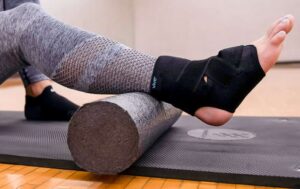 Suffering from a broken foot can feel like a major setback if you lead an active lifestyle. However, it doesn’t necessarily mean you have to stop exercising altogether. While high-impact activities like running or jumping are off-limits, there are plenty of other ways to maintain your fitness during recovery. Exercising with a broken foot involves modifications to your usual routine, ensuring you do not impede the healing process while keeping fit.
Suffering from a broken foot can feel like a major setback if you lead an active lifestyle. However, it doesn’t necessarily mean you have to stop exercising altogether. While high-impact activities like running or jumping are off-limits, there are plenty of other ways to maintain your fitness during recovery. Exercising with a broken foot involves modifications to your usual routine, ensuring you do not impede the healing process while keeping fit.
Consult Your Doctor
Before starting any exercise regimen with a broken foot, consult with your healthcare provider. Your doctor can advise you on which activities are safe for you and what you should avoid to prevent complications. They might also refer you to a physical therapist who can tailor a suitable exercise program to your specific needs.
Safe Exercises to Perform with a Broken Foot
1. Abdominal Workouts:
Strengthening your core does not require mobility in your feet. You can perform various seated or lying down exercises:
- Seated Russian Twists: Sit on the ground with your legs extended, lean back slightly, and twist your torso from side to side.
- Floor-Based Leg Raises: Lie on your back and slowly raise your legs to a 90-degree angle, then carefully lower them back down.
2. Push-Up Variations:
Modify your push-ups to avoid putting any weight on the broken foot:
- Knee Push-Ups: Perform push-ups from your knees instead of your toes, keeping weight off your injured foot.
- Upper Body Lifts: Use a stable chair or bench to perform arm lifts and presses, which will help maintain upper body strength.
3. Upper Body Strength Training:
Utilize resistance bands or free weights to perform upper body exercises that don’t require standing:
- Seated Bicep Curls: Sit on a chair with your feet flat on the ground, curl weights from your thighs up to your biceps.
- Overhead Tricep Extensions: Sit or stand with your back straight and raise a dumbbell over your head, then lower it back by bending your elbows.
4. Stationary Cycling:
If your cast or brace allows, use a stationary bike with no resistance. Cycling can help maintain your leg strength and cardiovascular health without putting pressure on your foot.
5. Swimming and Water Aerobics:
If your doctor approves, swimming can be an excellent way to stay fit with a broken foot. The buoyancy of the water reduces stress on all joints and limbs:
- Water Aerobics: Join a class to perform exercises in water that will keep stress off your feet while providing a full-body workout.
- Freestyle Swimming: Depending on your foot’s condition, gentle swimming without flip turns can be beneficial.
When Exercise Can Be Detrimental
Avoid any form of exercise that involves putting weight or pressure on the injured foot. Activities like walking, jogging, or any weight-bearing workouts can exacerbate your injury and delay healing. Always wear your prescribed orthotic device or cast when performing any physical activity to protect your broken foot.
Keeping Fit With a Broken Foot: Your Path to Safe Recovery
With the right precautions and adaptations, exercising with a broken foot is entirely possible. Focusing on safe, low-impact activities will not only help maintain your physical health but also improve your mental well-being during recovery. Remember to listen to your body and stop any activity that causes pain in your injured area.
Looking for professional advice on how to exercise safely with a broken foot? Schedule an appointment with Southwest Foot & Ankle by calling our offices in Plano, Lewisville, Irving or DeSoto. Let our experts guide you through a personalized exercise regime that ensures your recovery is quick and healthy. Stay active, stay fit, even with a broken foot!
Contact us
Schedule an appointment
with our podiatrist by contacting us or calling our:
